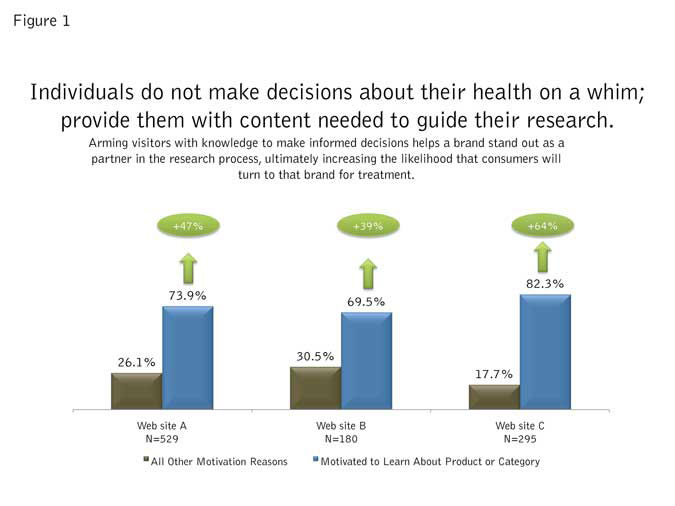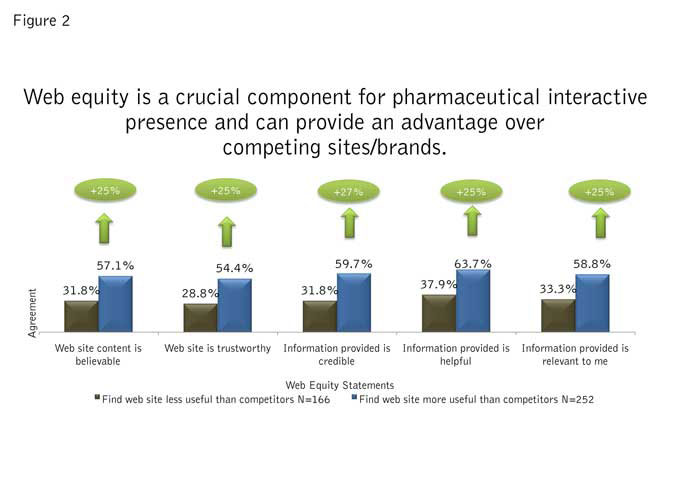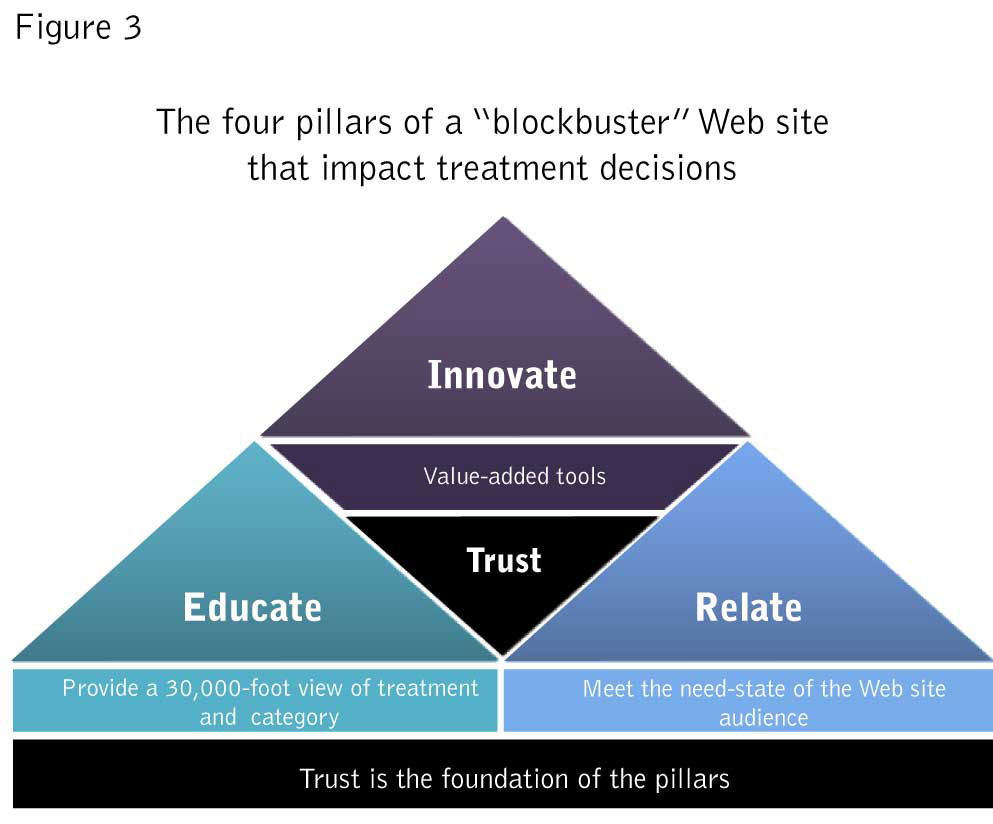Five best practices for pharma-brand Web sites
Editor’s note: Kimberly Struyk is director of client service at CRM Metrix, Secaucus, N.J.
Being entrenched in Web site measurement day in and day out for the last few years, I’ve seen Web metrics become an essential part of executive-level decision-making, especially within pharmaceuticals. In an industry like pharmaceuticals, in which consumers can feel both overwhelmed and undereducated by the information that’s available (and, as a result of that confusion, distrustful), maintaining an influential pharmaceutical-brand Web site that satisfies all visitors - from sufferers to caregivers - is no easy feat.
Still, it can be done, and I have watched some best practices take shape for doing so. Bear in mind that these best practices are merely the basics and a good starting point to propel digital branding forward.
The key to unlocking the power of the brand Web site is to design it from a consumer point of view, by listening to and observing Web site visitors. There are some fundamental themes that occur when monitoring visitors and linking their thoughts to the performance of the Web site. Just as the digital medium is growing in importance, these Web site fundamentals should be as well.
1. Satisfy the need-state.
Sufferers and caregivers have different needs; a successful pharmaceutical-brand Web site will fill the need-state gap.
Time and time again, we see many different types of visitor profiles while looking across the full spectrum of Web site visitors. On the consumer side, both sufferers and a large majority of caregivers decide to visit pharmaceutical Web sites. The key takeaway here is that if two unique groups have two unique sets of needs, they will likely respond to the Web site differently, especially if the needs of each group are not being met.
Companies must take the time to develop content that satisfies both groups, even if it means providing the same content through different avenues or tones. Typically, caregivers yield an even more pointed challenge than sufferers, as they must address the disease head on while also offering a helpful and supportive hand to the sufferer.
The question is, which type(s) of information will be relevant to both groups? Does each group call for a different Web site and a different campaign, SEO/SEM, etc.? The data collected has shown that this is usually not the case; after all, the site is already capturing these two mutually-exclusive audiences. Instead, it is important to provide the information clearly and concisely and organize the Web site in a manner that responds to the two different need-states or pretenses under which these groups are arriving to it. Following this best practice can foster long-term partnerships with either sufferers, caregivers or both groups and ensure that Web site satisfaction and usability are taken to the highest level of customer service.
2. Sufferer or caregiver - knowledge is power.
Educational material about the disease/condition is always widely desired. Therefore, a good start is to always (and we mean always) use the site as an educational tool about the disease. On average, about seven in 10 visitors come to the brand medication Web site to learn about the product or the category (Figure 1), even though there is a flood of information available through the many online medical portals. This indicates that consumers look to the brand for education about medication in conjunction with a 30,000-foot overview of the category, disease and treatment.
A common argument when discussing this topic is that consumers are still wary of branded pharmaceutical information. We present a reverse argument: Isn’t it time to provide these consumers with the information needed to increase trust levels? Knowing consumer wants and needs on a firsthand basis will help the pharmaceutical industry deliver in a more trustworthy manner. This is of course part of a recent trend that shows more consumers now than ever are likely to visit branded Web sites.
Even more importantly, sufferers do not usually make decisions about their treatment path on a whim, so it is mandatory for brands to guide sufferers in their online research. Brands have the opportunity to stand up as a partner in the treatment decision-making process. Creating the Web site as a one-stop shop for disease-state information is a proactive approach to being heard as a brand and to aid in solidifying sufferer decisions while cutting out other outside influencers. At the end of the day, this instills trust among consumers and increases the likelihood that they will request a script, ultimately moving more prescriptions into their medicine cabinets.
3. Web equity is integral in Web site performance.
“Web equity” may sound like a new concept to some, while brand equity most likely does not. Think of the Web site as a platform that showcases brand equity. To quickly define the Web equity concept, it is messaging that can be built and established through Web site content. The Web site can do a brand justice or injustice depending on how it is utilized.
Let’s take a moment to think about how Web equity can impact a brand, or in this case, how it has impacted the pharmaceutical industry as a whole. As mentioned above, previous research has shown that trust tends to be low among pharmaceutical-brand Web site visitors. Digging a little deeper, this corresponds with the Web equity that has been built since the onset of the digital era and subsequent Web site development.
It is fairly apparent that the concept of Web equity may have been overlooked or messaged improperly for years. The industry as a whole now suffers and is left to pick up the pieces by ensuring the concept is fully grasped and delivered appropriately in the future.
So how can we move forward from here? First, be aware that Web site content holds a certain equity or power for pharmaceutical brands. Research has identified that a few distinct Web equity metrics such as relevance, trust and credibility must be monitored at all times. If these attributes decay, the breadth of the site content will not exert much influence over the treatment decision and can in fact steer visitors away, as seen in Figure 2. Visitors not in agreement with Web equity statements will not find your Web site as useful as a competitive Web site that provides these subtleties in content and messaging.
Overall, Web equity is a catalyst that sparks a positive change in positioning, thereby having the power to influence competitive positioning. Time and time again, it is uncovered that Web site optimization is needed from a content/messaging perspective over a usability perspective: It is this very concept that often feeds into those strategies and recommendations.
4. Appreciate the impact of product testimonials and put them to good use.
Product testimonials are usually sought after, especially within the pharmaceutical industry. This is particularly true with regard to life-threatening categories, where support and confirmation about treatment of choice are needed on a continual basis. Moreover, testimonials can help strengthen the Web equity platform and move sufferers down the treatment funnel.
As discussed previously, Web site visitors seek to become educated and informed about product information when coming to the branded Web site. Moving beyond the basics, testimonials can aid in a sort of disease-state digestion. When utilized correctly, testimonials featured on brand Web sites provide a means of coping on an emotional front by educating through the hands-on experience of other sufferers.
While testimonials provide consumers with reassurance that can help guide their treatment decisions, they also help facilitate positive ratings for the Web site experience. When testimonials are featured on a pharmaceutical Web site, metrics have in turn achieved double-digit lifts that range from 10 to 24 percentage points higher than without testimonials. The brand Web site is a great stage to create this type of emotional camaraderie that can propel site performance and equity scores into new realms of success.
5. Do more than the bare minimum - think Web 2.0.
From a usability point of view, always implement value-added Web site features. Functioning in the time warp of the digital era, brands should already be beyond the basic nuts and bolts of site performance, (i.e., easy to navigate, a polished appearance, loads quickly, etc.). There are simple adjustments and tools that can be added to Web sites to attach value to the experience. Research shows simplified condition and symptom trackers prove to be most beneficial to those experiencing an ongoing condition or who have been newly diagnosed with the condition.
To deliver on the need-state, understanding the mind-set at the time of diagnosis is advantageous. Sufferers generally look to outline goals after first researching the condition and treatment options. This planning process is necessary to set goals and deal with the condition, which can often seem distant to the sufferer at the time. Catering to this mind-set enhances hope that the sufferer can turn their condition around or at least learn to cope. For those suffering from a chronic condition, it is expected that a brand should assist in condition management by providing useful tools.
More often than not, static tools (PDFs, downloads) are housed on pharmaceutical Web sites and still fit into the Web 1.0 mentality. This means that the tools usually are great ideas but their design and placement on the site are not being maximized. These elements were not built to be fully engaging and attract repeat users.
As Web sites evolve, we recommend using the same tools that are appropriate for the condition at hand but bringing them to life through interactivity between the brand and the consumer. One piece of advice for doing just this is to build these tools from a lifestyle change point of view. For example, a tool that provides recommendations for a lifestyle change would be better received if there is a personalized touch associated with it. Taking the sufferer’s current lifestyle into account (i.e., hours of work, exercise habits, activities, roles and responsibilities, etc.) will provide a more targeted solution. This will deliver the most relevant insights that can be put into action after consulting a pharmaceutical Web site.
It should be noted that these interactive features are somewhat ahead of industry trends and can be advantageous to early-adopters. Once they are established across all Web sites, mobile phone apps may increase in popularity and be applied for condition-tracking tools. Convenience must always be at the forefront of design.
Four pillars
Underlying the aforementioned best practices are four pillars to pharmaceutical Web site success that should feed into design fundamentals for this type of digital platform. These four pillars should remain top of mind when assessing your current site, optimizing it further or designing a brand new initiative.

Upon comparing your current Web site to the four pillars, if you find the site is off-target, begin closing the gap by addressing these details accordingly. Once the gap is closed, it is then time for attitudinal measurement to learn the dos and don’ts for your Web site audience. Web site measurement will get the ball rolling for the optimization process but before doing so, keep this tip in your back pocket: Traditional metrics and methodologies used to measure impact can still be applied to measure your online digital initiatives. Accountability to justify investments is often the first barrier that is faced when entering into measurement for the digital arena.
While attempting to build Web equity, improve the customer service platform or whatever your objective may be through the online initiatives, remember these best practices and always to put your visitor first. And perhaps even more importantly, track the initiatives to make sure they are working.
